As part of the celebrations of Cisco Talos turning 10, we’d like to take you back to where it all began: How we formed our mission of protecting our customers and making the internet suck a bit less, an insight into our culture, and how we came to work with some of the most talented human beings on the planet.
This is the history of Talos, as told through the eyes of some of our senior leaders.
The Sourcefire years
Editor's note: Sourcefire was a company that specialized in Firepower network security appliances based on Snort, an open-source intrusion detection system. Sourcefire was acquired by Cisco for $2.7 billion in July 2013.
Matt Watchinski, Vice President of Talos: What I remember most from the early years of Sourcefire was all of us being crowded into a minuscule meeting room. We spent our days discussing huge, complicated s**t. There was so much mutual respect and understanding for what we set out to achieve.
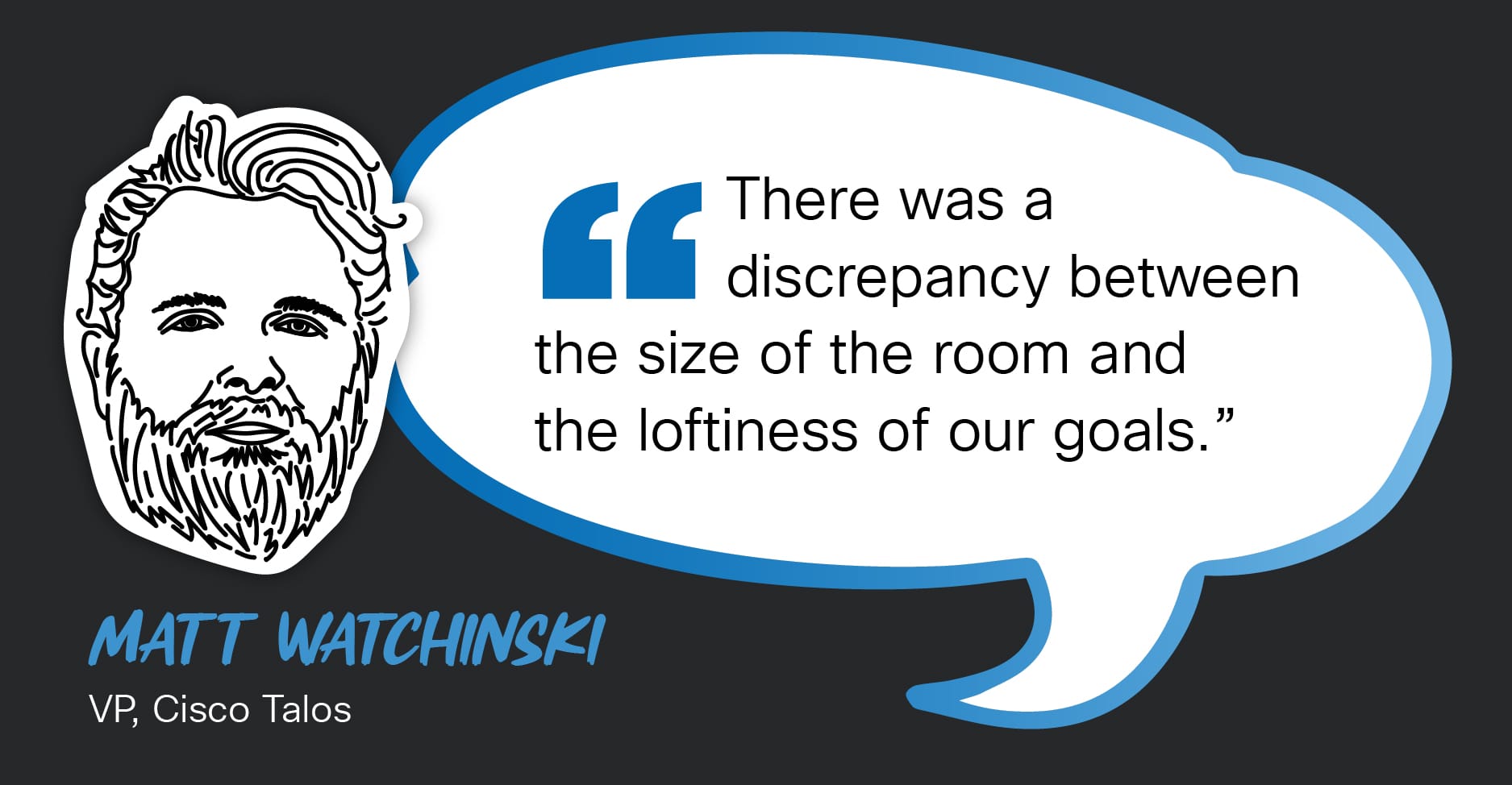
Chris Marshall, Director of Talos Network Detection and Response Team: We all collectively believed that we could be the best security team on the planet. We were so passionately driven to achieve things together. And we went out of our way to take care of each other to make sure those two other things happened.
Watchinksi: We had a group that could change priorities on a dime, and then actually execute on them — without anybody coming back and saying, “The dumbest decision in the entire world was just made in that tiny room. Now we have to go and do stupid s**t.” Everybody came back from that room and said, “Alright, this is the thing that's going to make Sourcefire the most successful, and so that’s the direction we’re going to march in.”
Lurene Grenier, Director of Competitive Analysis: At Sourcefire our goal was to build the best and most open product we could. At the time, all the rules had to be written by hand, without any guidance. We had no contracts with any companies. The biggest thing on the map at that point was Patch Tuesday bugs, and they were all remote root bugs. Every month, 15 - 20 of those bugs would get dropped. It was my job to grab the patches, patch the systems, reverse engineer the patches, and write an exploit for the bug. And then I would pass that exploit to the team who wrote the [Snort] rules. We would write the documentation, package everything up, and send that to QA.
We significantly changed the security posture and behaviour of Fortune 50 companies on the regular, with about 30 people. We were doing things that the industry said was impossible. And my favorite part was we had executives from those Fortune 50 companies coming out to buy us lunch, begging us to stop telling the public the truth.
The acquisition of Sourcefire
Marshall: I came to Sourcefire from the U.S. military. I had no idea what being acquired meant.
Watchinski: We had been in negotiations with Cisco for about six months. I couldn’t tell anyone about that though. Those final negotiations went on until 4 a.m. the morning that the deal closed. We didn’t stop until we had reached a deal that was right for our people. At 4:30 a.m., I sent a text to my directs, telling them that something big was happening, and they should come into the office at 7 a.m.
Marshall: At the time, I ran the response work. And Watchinski didn't tell me if there was a problem. So, my instincts told me something was very wrong. “Who else do I need to call? How bad is the situation?” And he just replied, “I just need you there first thing in the morning.” So, the next morning Watchinski walked in, and me, [Matt] Olney [Director of Threat Intelligence and Interdiction] and Nigel [Houghton, former director of Talos Operations] are standing around anxiously. And then Watchinski said, “Cisco just bought us. We're not working today.”
Three teams coming together
Watchinski: For the first year after the acquisition, Sourcefire continued as the VRT (Vulnerability Research Team). During that time, we met various people across Cisco and tried to figure out what they all did. One of the people I met was Luci [Lagrimas]. She’s an incredible person, and we started hatching a plan on how we could be successful together.
We proposed bringing together a singular set of services, a singular threat research and intelligence team, a singular understanding of our data, and a singular voice of how we talk about security.
I gave a presentation to what was then three different groups — VRT, Cisco Threat Research, Analysis and Communications (TRAC), and Security Applications (SecApps).
Luci Lagrimas, Senior Director of Engineering: That was a day I’ll always remember. We all gave presentations about who we were and who our teams were. I put three pictures on an “About Me” slide, and one of them was me playing field hockey, wearing a T-shirt that definitely showed off my guns. [Matt] Olney leans over to Marshall and says, “Dude, she can kick our ass!”
Matt Olney, Director of Talos Threat Intelligence & Interdiction: This remains true to this day.
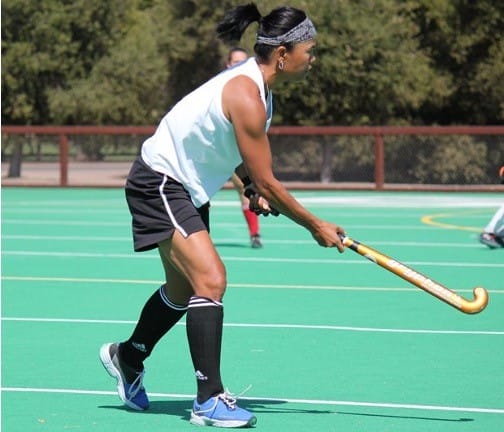
Marshall: My first impression of Luci was that slide. That set the tone for these teams coming together, because here’s this badass lady with a field hockey stick causing carnage on the field, and that’s what we were going to bring into our group.
The Talos brand is born
Lee Jones, Talos distinguished engineer: My first exposure to Matt [Watchinski] was a cultural definition point, because Matt came in and did what he’s great at, which is coalesce things. It was incredible to watch how he started forming the vision of what Talos was going to be.
Watchinski: I believe that to have an effective team, you need three things: a mission that everybody understands, a culture that everybody can work in, and some type of icon that people can rally behind. A colleague of mine would always say, “This is how you build a cult!” And I would reply, “Yeah, kinda...but the good kind of cult.”
I knew that having three different brands and messages wouldn’t work. We needed the branding to reflect on who we were as a new team coming together. That was a point of unity — giving up what the VRT had built from a brand perspective for over 10 years. And asking the others to do the same.
Luci: Between April and August 2014, the team leaders all threw different ideas into the ring about what we would be called and what sort of brand could represent who we were becoming.
Watchinski: If I remember it right, it was Matt Olney who came up with Talos, protector of the shores. That one resonated most with everyone, because it aligned with our main mission of protecting our customers.
Matt Olney It came about because we wanted something big to represent us. We were now part of a team that was focussed on much more than vulnerabilities. We wanted to have a larger voice as an organization, and a larger role in security consciousness.
Luci: Talos was officially launched at BlackHat in 2014.
The team grows
Liz Cooperrider, Leader, Talos Project Management Office: When I started reporting directly to Matt [Watchinski] he elevated the Project Management Office (PMO) and the value of what we brought to the organization.
Since 2019, we’ve been able to grow and become an integral part of Talos, mainly because I was given a lot of independence and autonomy from the team.
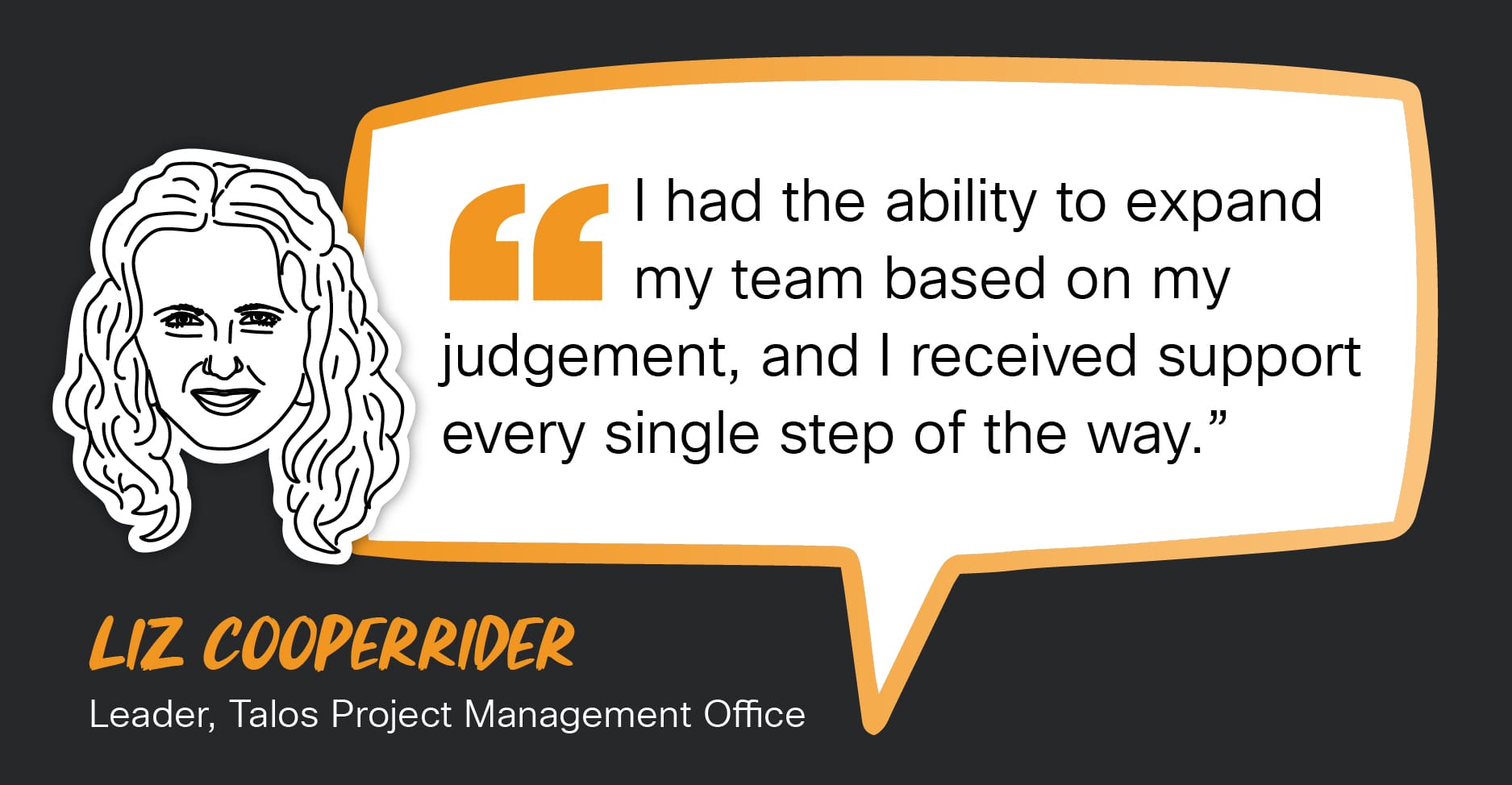
Lee: After Talos was formed, I was working across the Cisco portfolio, helping them to design products from a security perspective. In 2018, I came back home to Talos. My role was to work with Luci to transition the architectural aspect of Talos, and get it to a trusted product partner level, global in scope and scale, beyond the core competency of the security mission.
We created a service delivery architecture called “Tomorrowland”. This was a big turning point. It didn’t change our security capabilities themselves, but our ability to project our power went up.
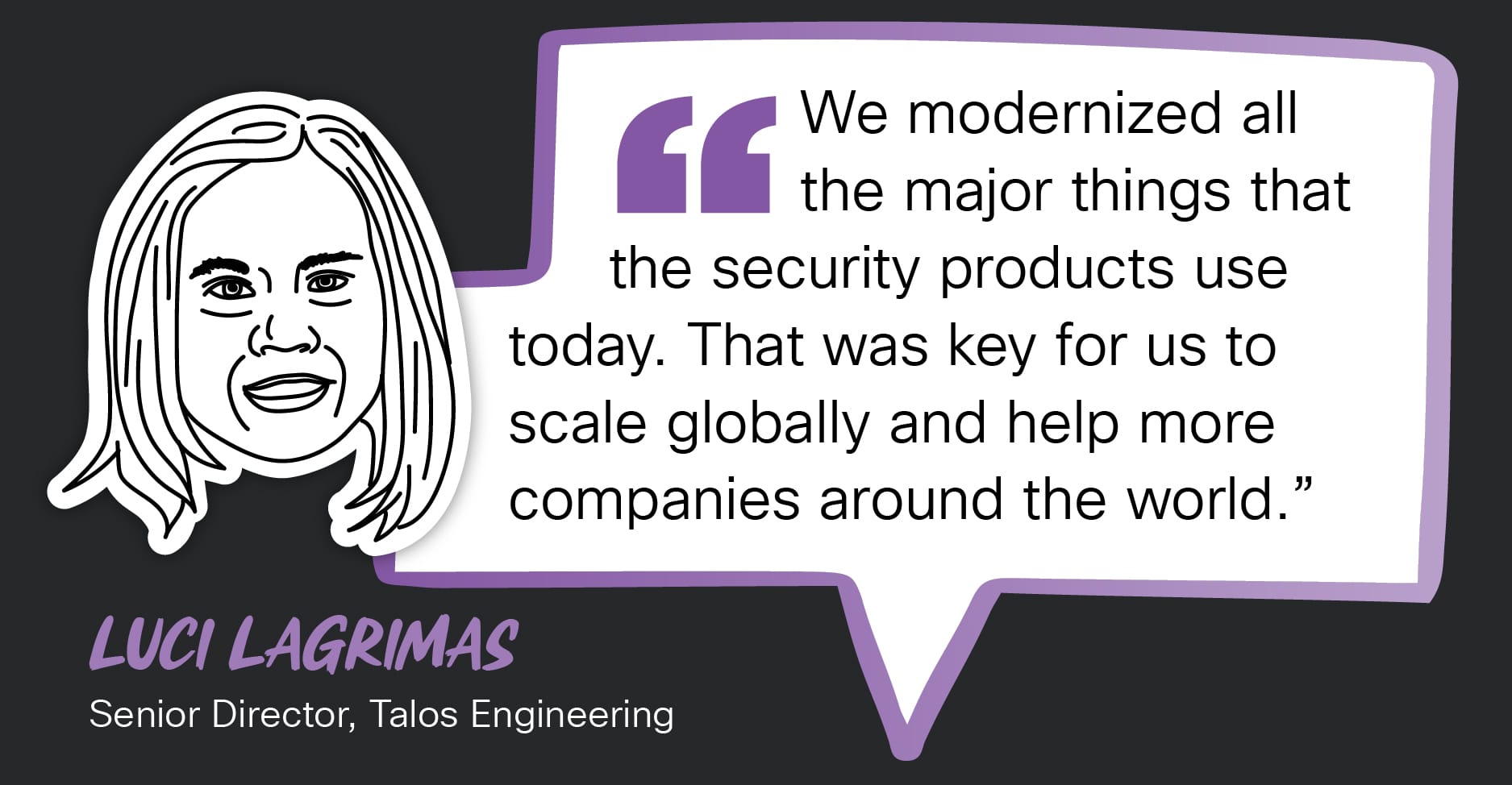
Lee: At a lot of other places, rank and hierarchy matter. Titles matter, and there can be a top-down approach sometimes. But at Talos, there’s a culture of asking questions and pushing back to see, “Do I really believe this and want to incorporate this to my mission?” That is very energizing. I sat back and thought, “This is where I want to be. I’m happy. This is what I was hoping for.”
Amy Henderson, Director of Talos Strategic Communications and Operations: I was a portfolio manager in the Customer Experience organization in Cisco, and at that time (October 2019), one of our key services was Incident response. The IR team worked very closely with Talos, sharing intelligence, understanding what's going on at a customer site when things go down, etc. We eventually came to the decision that Incident Response should become Talos Incident Response, bringing those teams under one umbrella.
I got to know Watchinski and Olney and really enjoyed working with them. But there was a moment during the transition that the Talos team pulled back. They said they wanted to pause things because it wasn’t being done in the right way. Not being part of Talos at that point, I really appreciated their honesty and integrity. Because when you’re working towards delivering on a priority, sometimes you end up just pushing the ball down the road without necessarily getting the outcome that you want. It’s important to take stock and think about, “Is this actually what we want to achieve?”
I pinged Olney and said how much I respected their decision. Because it showed the character of the Talos team. They’re not going to rubber stamp everything and say it’s OK when it’s not.
Brad Garnett, Director of Talos Incident Response: I was another Talos transplant. I was running the Incident Response team on the CX side, and as Amy mentioned it made sense to bring us into Talos. Response and intelligence are like peanut butter and jelly, it just goes together.
We gathered in London in the fall of 2019, and we talked about what IR might look like inside of Talos. Our brand, reputation, integration, intelligence services etc. I still have that agenda from nearly five years ago, and I still remember our first three customers.
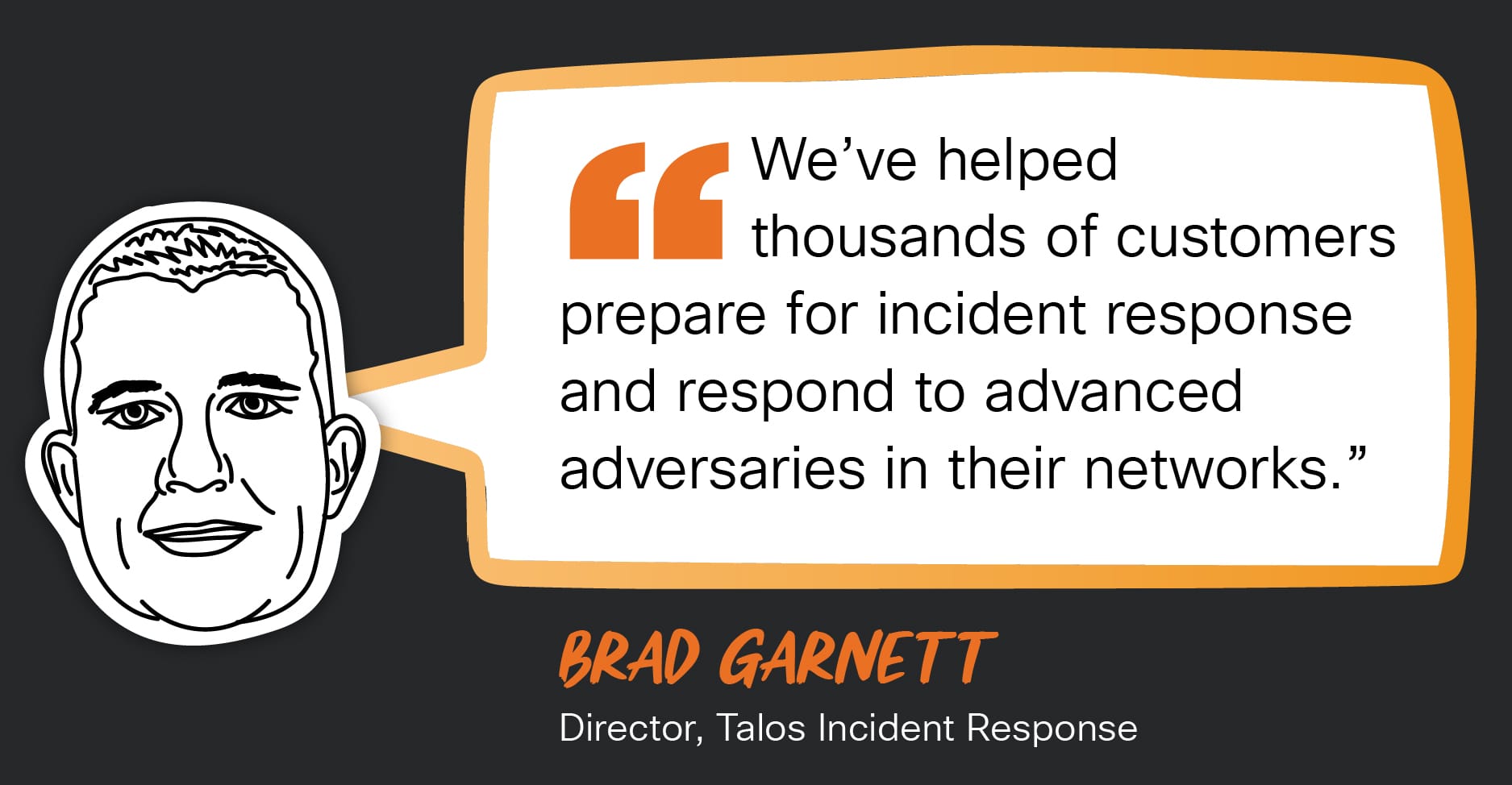
That helps me bring perspective — no matter how challenging things get, we’ve hugely grown in scale. Customers need us more than ever. And our mission has grown to not just helping customers on an individual level, but to use that experience to protect all our customers. “The power of the debrief”, as I frequently say to my team. Take what we’re seeing and go help more people.
The mission
Olney: When people ask me what I do, I tell them, “I build the expertise that allows me and my team to go places and fix things.” I’m most proud of the work that we do that makes no sense from a corporate or financial perspective, such as the election security work, the work we’ve done to protect Ukraine’s critical infrastructure…the stuff that doesn’t turn a dollar but makes the world a better place. To do all that within a capitalistic entity is pretty remarkable.
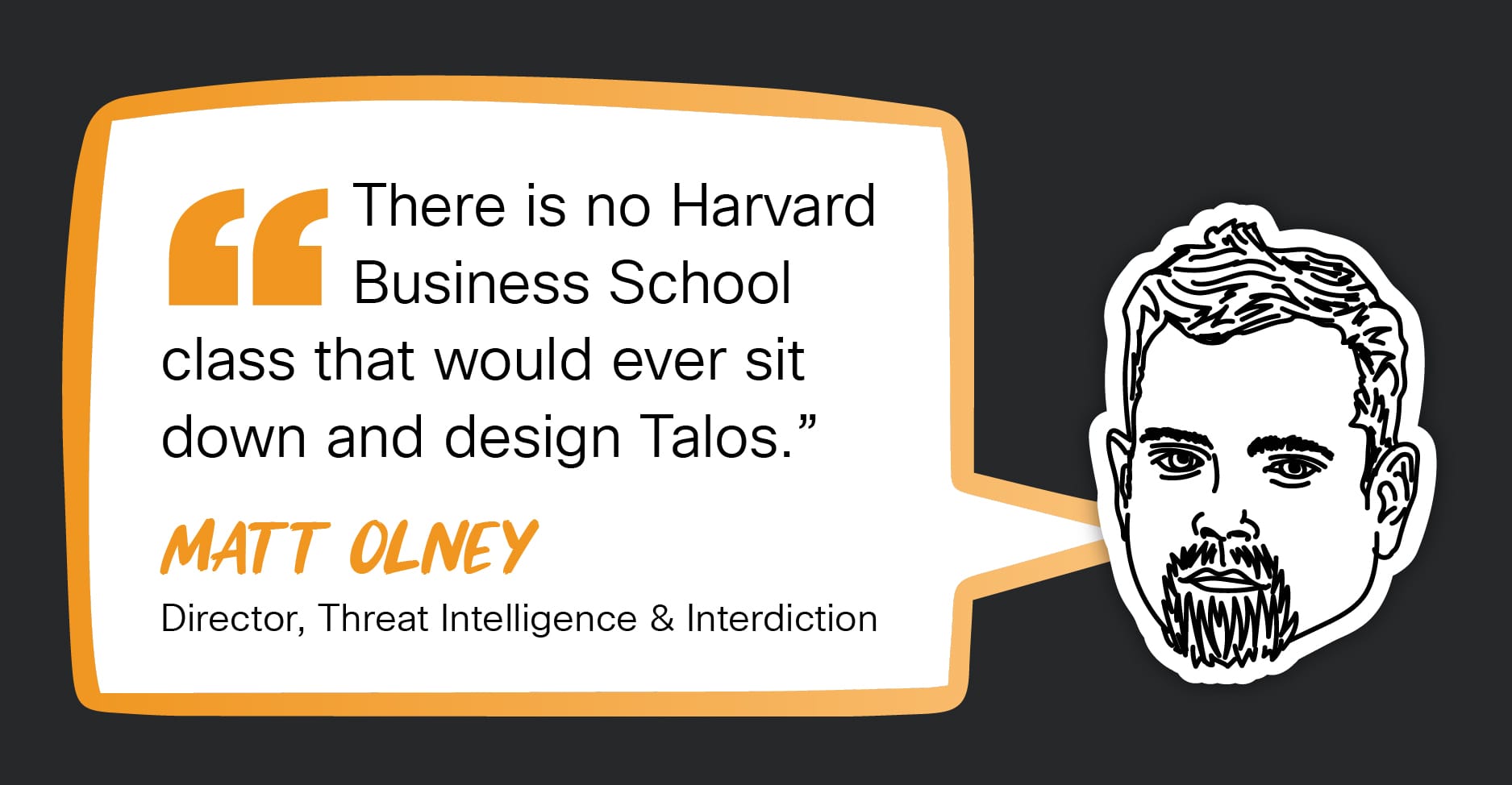
That’s what makes me so proud of this team. We approach security problems as, “How can I positively affect the most amount of people?”
Luci: Whenever I see Talos in the news, I feel really proud to be a part of an organization that isn’t out there just for the money. We’re out there to make the world a better place.
Watchinski: The work we did to help Ukraine, to fill 747s with Cisco kit and fly into a country at war….being able to actually support their operations from either afar or in country, help protect their people, help them turn back on civil infrastructure so that trains run, telephones work, payment processing is functional, the basic needs of society are still met, even though adversaries are actively trying to bring those things offline… I don't think there's a ton of companies that can say they have the capability to do those things. Or even the will to do them.
Amy: And then on top of that, you have Joe Marshall’s Project PowerUp work which helped keep the electrical grid in Ukraine running after disruption from GPS jamming. Joe, on his own terms, found the right people, pulled volunteers together, and we were able to build something to help the grid maintain better time so Ukrainians can have more stable electrical power.
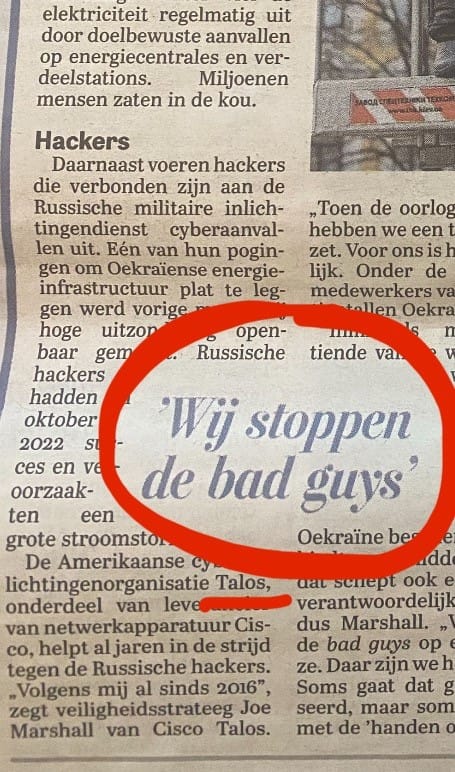
Marshall: When we can pull off that kind of thing, it’s because of the trust that we have. More people today trust us than ever before. And I think that trust is well-deserved because of the solid information we can provide.
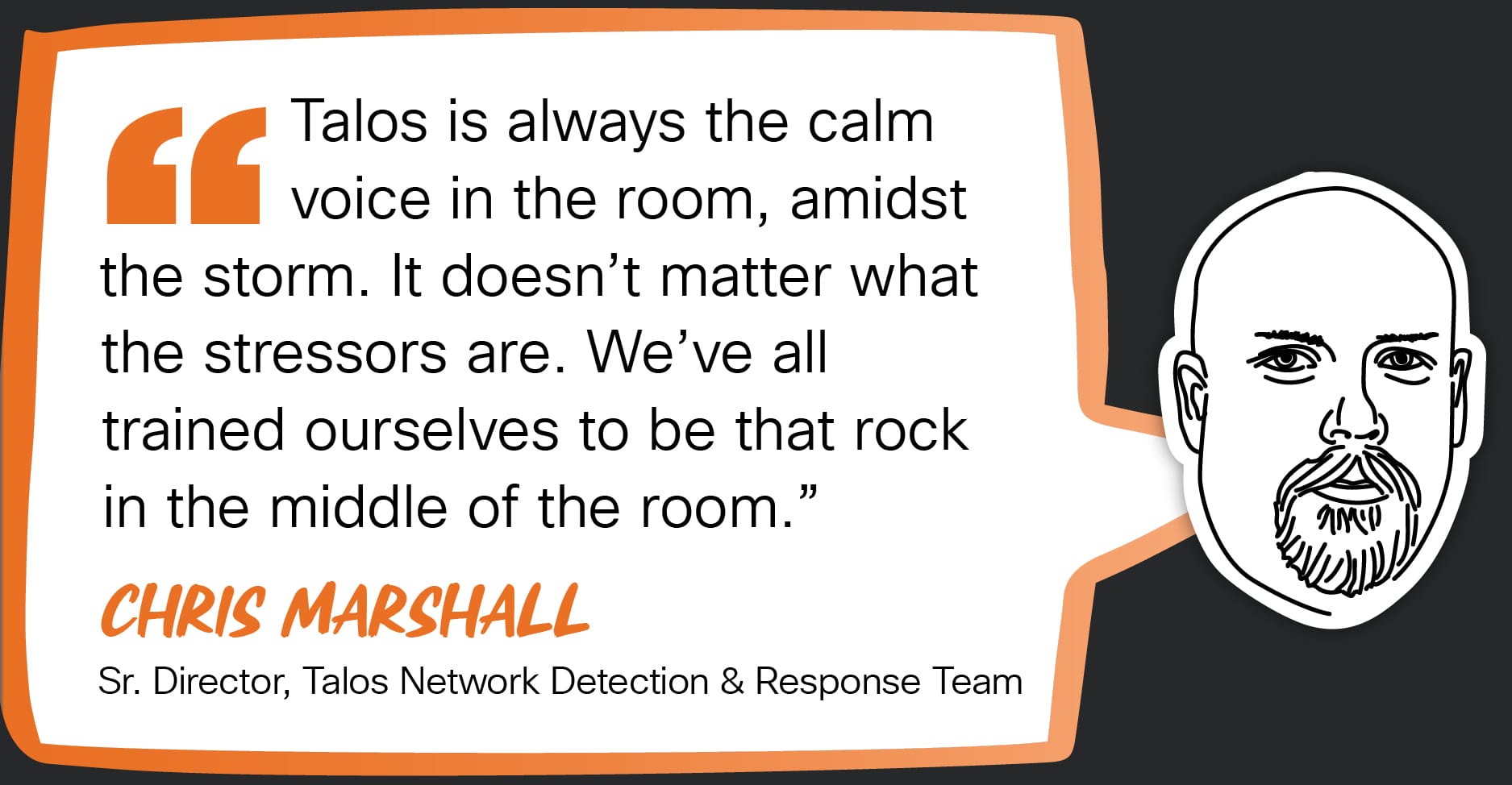
We bring verified information our customers can act upon, as well as bringing calm to a situation so we can encourage reason. We keep doing that no matter what else happens, and that gives people peace of mind.
Amy: What’s common amongst the folks that we hire is they know that sometimes they’ll need to drop everything and pivot to a rapid response effort. I hope they know that our leadership team fights to give them air cover to a) keep them sane during those times, and b) makes sure that they have what they need. As a leadership team we fight for budgets and time and resources that can help them, because our people have such an innate sense of doing the right thing. We know that the lengths that people go to, and that's one of the many reasons why we will protect them every single day.
Our culture
Lurene: In the early days of Sourcefire, there was no situation that came up where we couldn't sit down together and come up with a plan to solve it. We would make it work, and in so doing, we would make a change in the industry. We were given the space to do that. Matt [Watchinski] would say, “Go figure this out, come up with some plans, give me three options, and then we're gonna pick one of them and do it.”
When I came back to Talos two years ago, I was so pleased to see that everybody had protected that culture and passed it on to new leaders in the group. I’m really proud of that.
It’s our job to make people feel comfortable who might not feel comfortable elsewhere. Developing a space for people who are extremely valuable team members but might have trouble thriving in an extremely generic environment. I am one of those people, so I know I can say that.
Olney: We want Talos be a thing that's worth being yourself with. Our culture is very conscious. We didn’t do a survey and figure out, “Employees are 2.5% more engaged if you give them free drinks.” They get to define who they are, and who they want to be at Talos. And they get to define what you want your experience at Talos to be like.
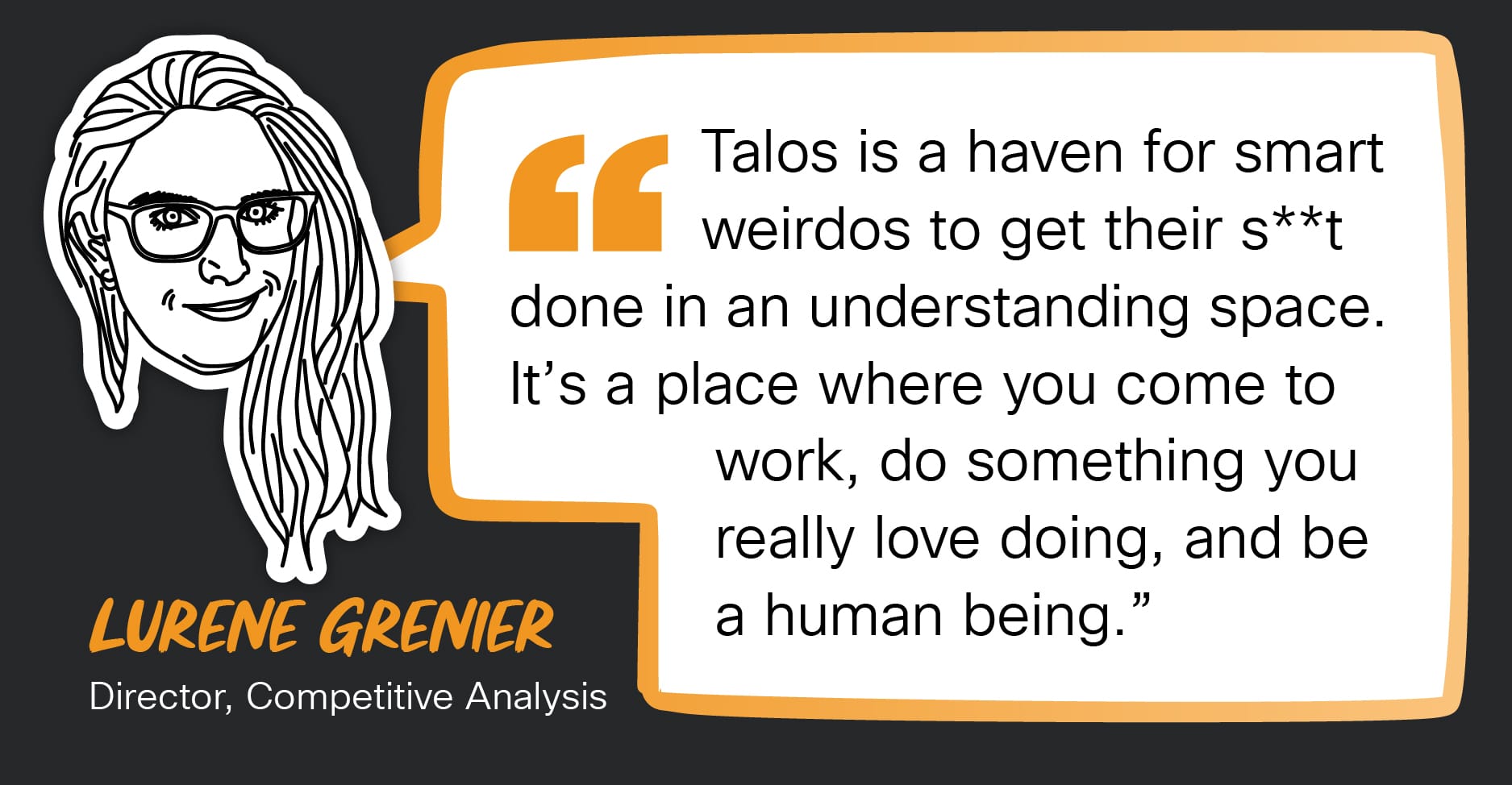
Liz: In other organizations, if a team doesn't make their deliverable, there’s zero compassion and no understanding – “Why did that fail?” Within Talos, we can fail and fail fast because there is so much clear transparency. That’s completely a part of the culture.
Marshall: It really is. Until I myself attain perfection, it’s unfair for me to expect perfection from anyone else.
Olney: We ask so much of our people. We ask them to move fast and make tough decisions. If we were set the tone that every time someone screwed up, it was a job threatening situation, then people would be far more hesitant. They would work inside of smaller boxes. They would think smaller, and they would act less boldly. They would fade into the background more often. That’s the exact opposite of what we want.
There’s no “Key performance metric” for Joe Marshall to build relationships with the Ukrainians and then come up with a solution that helps them keep the lights on. It’s just what we do…it’s just what we, as Talos, do.
Watchinski: Our culture is the thing I’m most proud of, of all the things Talos has achieved over the past 10 years.
Liz: Talos is also very family first. I remember once I was caring for my father. He had had a hip replacement, and I was to take care of him when he came home from the hospital. I thought I could do it by myself – be his 24-hour nurse and do my job at the same time. I showed up to a sync with Chinski, and he immediately knew something was wrong. He wasn't interested in any of the business side of things. He simply said, “Go. Go take care of your father.”
Marshall: I stand by the idea that if I take care of my people, my people take care of me. That’s something I ask of all my managers — just take care of your people. The No. 2 thing I ask is to meet the needs of the business.
Watchinski: A lot of people in this organization have been with me for 5,10,15 even 20 years. They’ve gone from junior analyst to senior director inside a Fortune 500 company. And even when you look at all the folks that have left the organization over the years, they've all gone on to do great things.
Marshall: No matter what, I want people to be better for their time spent with us. And if they exit tomorrow but they’ve accomplished that, then we’ve done our job.
Brad: People who have moved on from Talos have said to me, “The Talos years are some of the best years of my career.” To me, that’s worth protecting.
For more Talos 10 celebrations, take a look at some our key moments:

